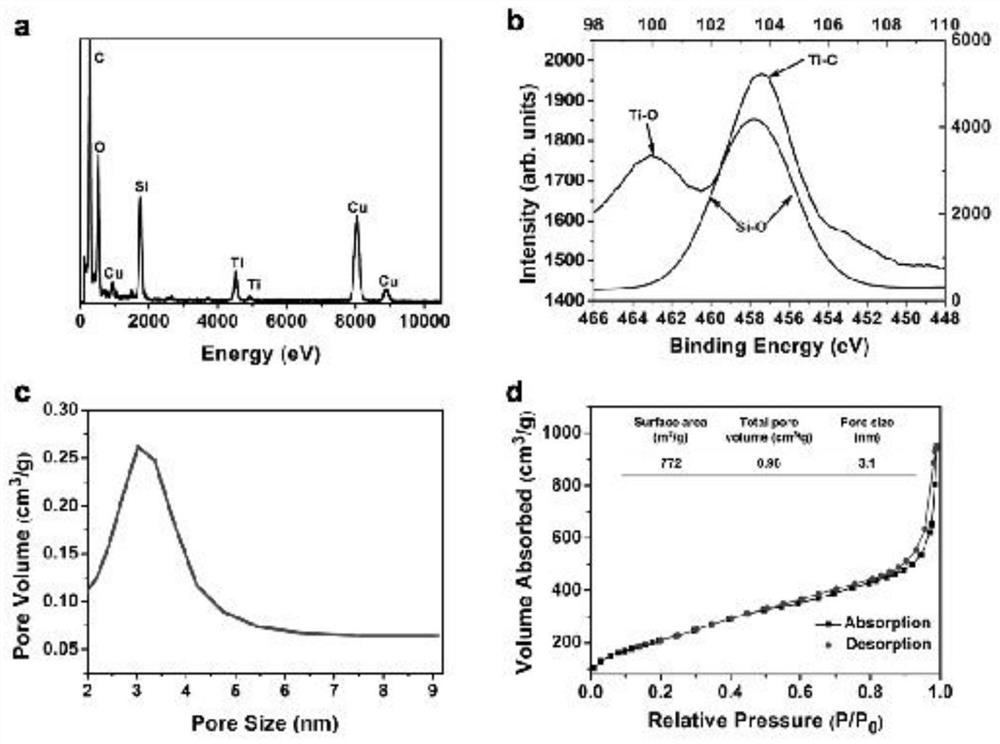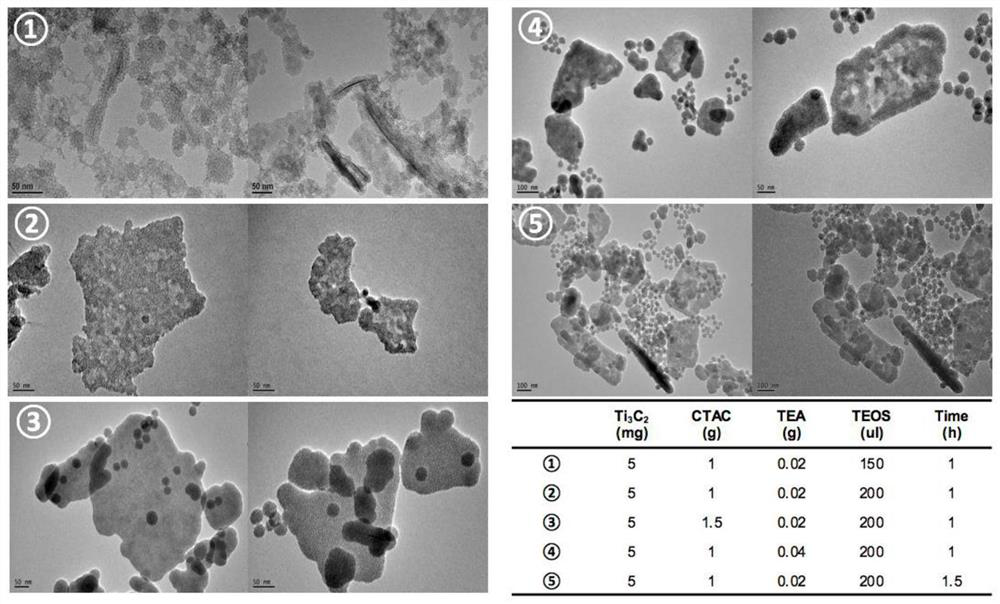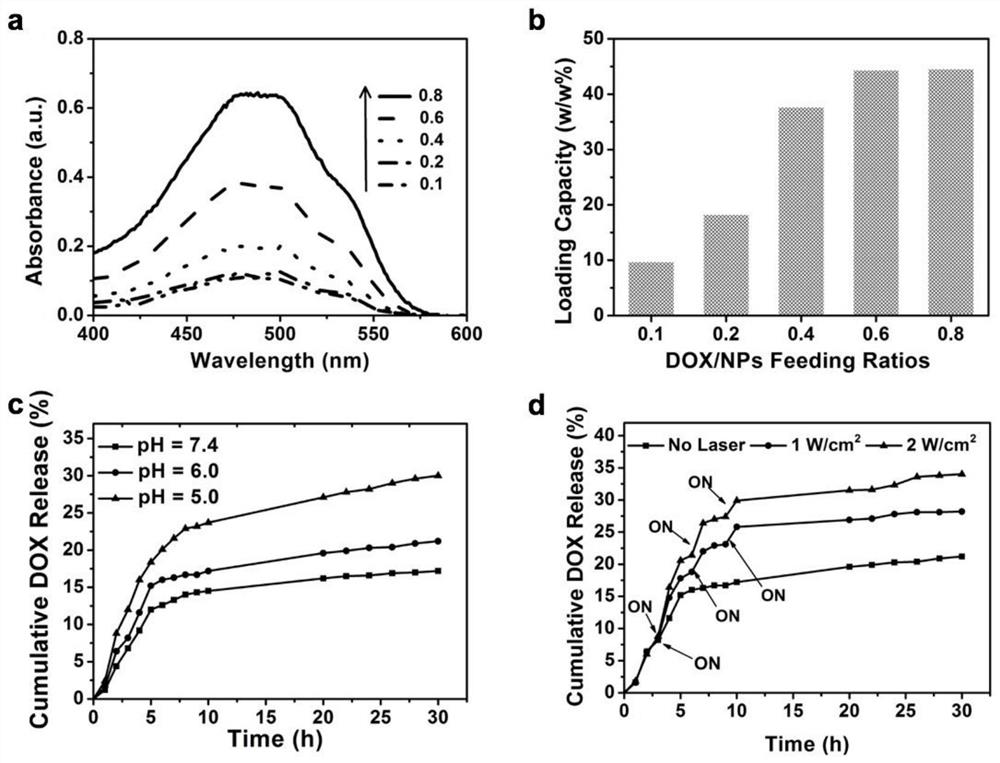A sustained-release preparation for tumor targeting therapy and its preparation method
A tumor-targeting, sustained-release preparation technology, applied in the nanometer field, can solve the problems of value discount, uncontrollable release and responsive release, unfavorable biological applications, etc., to achieve improved ablation effect, stable drug loading with high drug loading rate , the effect of excellent drug loading rate
- Summary
- Abstract
- Description
- Claims
- Application Information
AI Technical Summary
Problems solved by technology
Method used
Image
Examples
Embodiment 1
[0061] Example 1 Ti 3 AlC 2 Synthesis of MXenes
[0062] Titanium powder (99.5% (w / w) purity, -325 mesh), aluminum powder (99.5% (w / w) purity, -325 mesh) and graphite powder (99.0% (w / w) purity, particle size less than 48μm, -300 mesh) in a molar ratio of 2:1:1, and then ball milled for 10h, pressed into a round cake under a pressure of 30MPa, and then put the round cake in the furnace under the condition of feeding argon , fired at 1500°C for 2 hours to obtain Ti 3 AlC 2 Ceramic material.
[0063] Ti 3 AlC 2 After the ceramic material is ground, collect 10g of powder and place it in 60ml of 40% hydrofluoric acid aqueous solution, carry out etching reaction at room temperature for 3 days, then collect by centrifugation and wash with water and ethanol, and then disperse in 50ml Concentration of 25% (w / w) TPAOH (Tetrapropylammonium hydroxide, tetrapropylammonium hydroxide) aqueous solution was stirred at room temperature for 3 days; then centrifuged and washed with water ...
Embodiment 2
[0065] Example 2 Synthesis of MXene nanosheets wrapped in mesoporous silica
[0066] 10g of 10% (w / w) CTAC (Cetanecyltrimethylammonium chloride) aqueous solution and 0.2g of 10% (w / w) TEA (triethanolamine) aqueous solution were pre-mixed and stirred at room temperature for 10 minutes, and then 10ml of concentration was added dropwise. The Ti obtained in embodiment 1 of 0.5mg / ml 3 AlC 2 The aqueous solution of MXenes was stirred at room temperature for 1.5 hours; then, 150 μl of TEOS was added and stirred at 80° C. for 1 hour; then the precipitate was collected by centrifugation and washed 3 times with ethanol. In the above-mentioned reaction process, CTAC can be used as a mesoporous structure guiding agent by utilizing ethanol and 37% hydrochloric acid mixed solvent (V 乙醇 :V 37%盐酸 =10:1) Washed three times for 12 hours at 78°C. Thereafter, after washing 3 times with ethanol and 2 times with deionized water, the resultant was dispersed in ethanol. Carry out in-situ bright ...
Embodiment 3
[0070] On the basis of the scheme of embodiment 2, this embodiment also investigated different Ti 3 C 2 Weight ratio of MXenes, CTAC and TEA and TEOS to Ti 3 C 2 The effect of volume ratio of MXenes material aqueous solution on the microstructure of the obtained material, the results are as follows image 3 shown.
PUM
| Property | Measurement | Unit |
|---|---|---|
| specific surface area | aaaaa | aaaaa |
| specific surface area | aaaaa | aaaaa |
| concentration | aaaaa | aaaaa |
Abstract
Description
Claims
Application Information
 Login to View More
Login to View More - R&D
- Intellectual Property
- Life Sciences
- Materials
- Tech Scout
- Unparalleled Data Quality
- Higher Quality Content
- 60% Fewer Hallucinations
Browse by: Latest US Patents, China's latest patents, Technical Efficacy Thesaurus, Application Domain, Technology Topic, Popular Technical Reports.
© 2025 PatSnap. All rights reserved.Legal|Privacy policy|Modern Slavery Act Transparency Statement|Sitemap|About US| Contact US: help@patsnap.com



